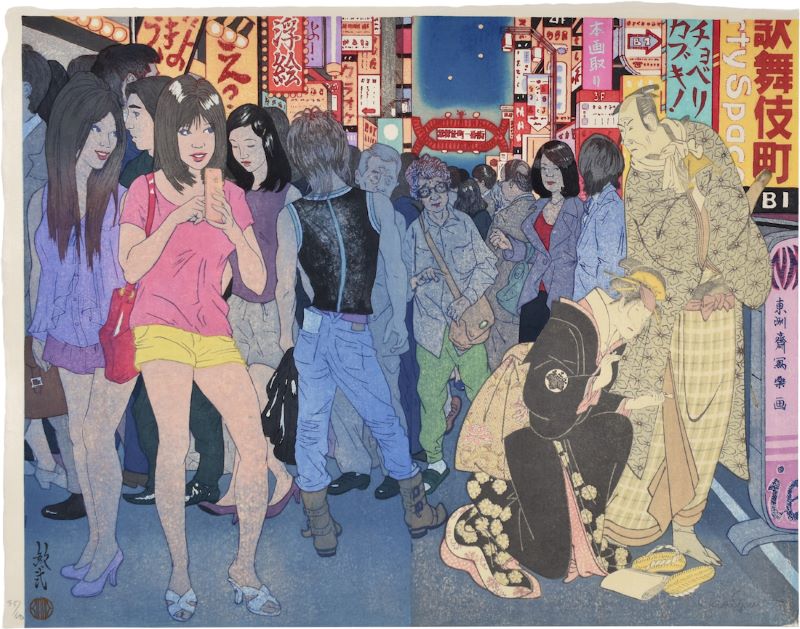

Paul Binnie
Scottish, b. 1967
Pictorial Allusions, Reused Blocks: Kabukicho
(Honga dori: Honga Dori: Kabukicho)
the series title, Honga Dori, in silver kanji at top of right sheet (incorporated into pink neon street sign) and the print title in red kanji, Kabukicho (incorporated into yellow sign at top right, and the ichiban-gai gate) signed in kanji, Bin-ni, on lower left followed by red artist's seal, Binnie, and silver seal on lower right, Binnie signed in pencil at bottom of right sheet, Paul Binnie, from an edition of 100, 2020
obaiban tate-e diptych 16 1/2 by 20 3/4 in., 42 by 52.7 cm
This diptych merges images from the past and present, combined together to create one striking piece. On the left two young contemporary women, in casual street clothes, stand amongst a bustling scene in the heart of Tokyo's entertainment district. With cellphone in hand ready to capture the moment they look coyly over to the right, intrigued by the two muted figures from the past who appear before them. With their traditional attire and mannerisms, the ghostly pair seem to be absorbed in the tasks they were performing from their 18th century Edo existence.
The two Edoites were created using antique reproduction wood blocks from a design originally by Toshusai Sharaku (fl. 1794-1795) depicting the kabuki actors Matsumoto Koshiro IV (fl. ca. 1780-1802) and Nakayama Tomisaburo I (ca. 1760-1818). The Sharaku signature is incorporated into the pink sign on the edge of the right sheet. In order to bring to mind traditional ukiyo-e prints of the past, the actors were printed with a neutral palette of colors representative of ones that were used in 18th century printmaking.
The brightly lit and colorful city scene that surrounds the actors is Binnie's own design. The neighborhood depicted is Kabukicho, an area in Shinjuko, Tokyo, which was developed in the post-war period from the burned-out rubble of the city. It was named for an expected kabuki theater as its center point, which for various reasons was never built. Nevertheless, the name Kabukicho stuck, and today the district teems with energy from diverse entertainments offered by numerous bars, restaurants, karaoke rooms, love hotels, and hostess clubs. The observers in the crowd are drawn from real people, and in classic ukiyo-e fashion, the artist incorporated word games into the signs above. Kabukicho, the print title, and Honga Dori, the series title, appear along the phrase 'cho beri kabuki' (it's really very kabuki) on the right sheet. The left sheet poses a question with the answer; 'Ukiyo-e? ukie yo!' (Is it ukiyo-e? It's a perspective picture [uki-e] in fact!)
(inv. no. C-3134)
price: $1,100






